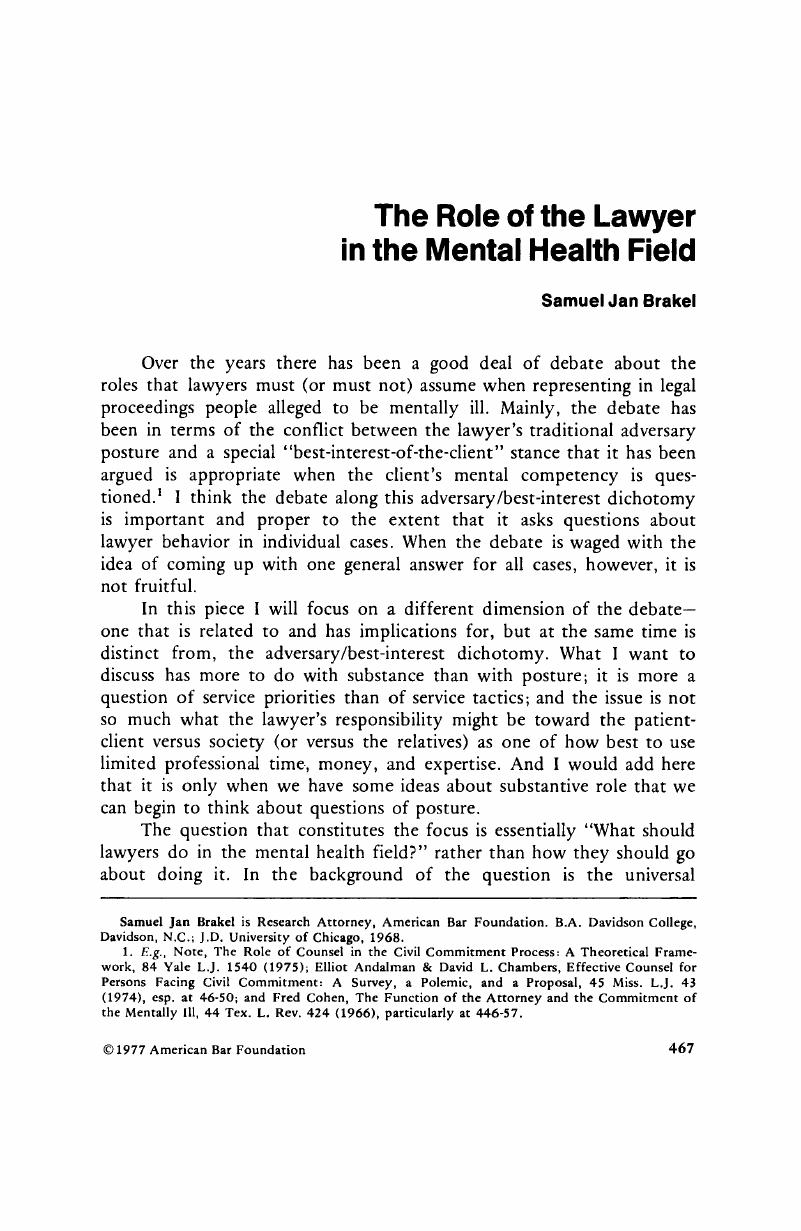Article contents
The Role of the Lawyer in the Mental Health Field
Published online by Cambridge University Press: 20 November 2018
Abstract

- Type
- Research Article
- Information
- Copyright
- Copyright © American Bar Foundation, 1977
References
1 E.g., Note, The Role of Counsel in the Civil Commitment Process: A Theoretical Framework, 84 Yale L.J. 1540 (1975); Elliot Andalman & David L. Chambers, Effective Counsel for Persons Facing Civil Commitment: A Survey, a Polemic, and a Proposal, 45 Miss. L.J. 43 (1974), esp. at 46-50; and Fred Cohen, The Function of the Attorney and the Commitment of the Mentally Ill, 44 Tex. L. Rev. 424 (1966), particularly at 446-57.Google Scholar
2 Admission statistics for Illinois in 1976 show 9,716 patients out of a total admission figure of 24,611 classified as schizophrenic. The next largest categories are “alcohol addiction” and “other alcoholism,” with 4,420 patients. Drug dependency accounts for another 1,041 admissions. “Depressive neurosis”–1,700 admissions–is the largest mental disorder diagnostic category after schizophrenia. Since alcoholic patients are usually separated from the general hospital population, patients labeled schizophrenic dominate the general wards all the more. See Illinois, Department of Mental Health and Developmental Disabilities, Fiscal Year 1976, Mental Health Statistics 53.Google Scholar
3 In Illinois today 70 percent of all admissions are technically voluntary. Id. at 47.Google Scholar
4 Two of ten demonstration projects recently funded by the American Bar Association Commission on the Mentally Disabled (the basic grant coming from the Edna McConnell Clark Foundation) will experiment with lawyers operating within the hospital. The Wake County Bar Association project will maintain a law office within Dorothea Dix Hospital in Raleigh, North Carolina. The Georgia Mental Disability Law Project contemplates the establishment of law clinics staffed by volunteer lawyers and law students at each of the state's regional mental hospitals. A third project, in eastern Nebraska, will operate with a nonlawyer ombudsman and a legal advocate, but neither will work primarily within the inpatient facilities.Google Scholar
Another experiment, the Pennsylvania Project, also sponsored by the ABA commission, employs an attorney-director and three staff attorneys plus a social worker to deliver services to patients of Norristown State Hospital just outside Philadelphia. The staff is housed principally on the hospital's grounds. The project has been in operation a little over a year.Google Scholar
Then there was a short-lived lawyer-ombudsman experiment at St. Elizabeths Hospital in Washington, D.C. See Albert Broderick, One-legged Ombudsman in a Mental Hospital: An Overthe-Shoulder Glance at an Experimental Project, 22 Cath. U.L. Rev. 517 (1973).Google Scholar
Finally, the state of New York has had an institutional lawyer program in operation since 1965. the Mental Health Information Service, a delivery concept which in New York is thus well beyond the experimental stage. N.Y. Mental Hyg. Law sec. 29.09 et sey. (McKinney 1976) originally Mental Hygiene Law sec. 88. Evaluations of this program can be found in Raj K. Gupta. New York's Mental Health Information Service: An Experiment in Due Process, 25 Rutgers L. Rev. 405 (1971); Note, The New York Mental Health Information Service: A New Approach to Hospitalization of the Mentally 111, 67 Colum. L. Rev. 672 (1967); also Andalman & Chambers, supra note 1, at 64.Google Scholar
- 5
- Cited by




